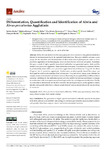2021-04-18Zeitschriftenartikel
Differentiation, Quantification and Identification of Abrin and Abrus precatorius Agglutinin
Worbs, Sylvia
Kampa, Bettina
Skiba, Martin
Hansbauer, Eva-Maria
Stern, Daniel
Volland, Hervé
Becher, François
Simon, Stéphanie
Dorner, Martin B.
Dorner, Brigitte G.
Abrin, the toxic lectin from the rosary pea plant Abrus precatorius, has gained considerable interest in the recent past due to its potential malevolent use. However, reliable and easy-to-use assays for the detection and discrimination of abrin from related plant proteins such as Abrus precatorius agglutinin or the homologous toxin ricin from Ricinus communis are sparse. To address this gap, a panel of highly specific monoclonal antibodies was generated against abrin and the related Abrus precatorius agglutinin. These antibodies were used to establish two sandwich ELISAs to preferentially detect abrin or A. precatorius agglutinin (limit of detection 22 pg/mL for abrin; 35 pg/mL for A. precatorius agglutinin). Furthermore, an abrin-specific lateral flow assay was developed for rapid on-site detection (limit of detection ~1 ng/mL abrin). Assays were validated for complex food, environmental and clinical matrices illustrating broad applicability in different threat scenarios. Additionally, the antibodies turned out to be suitable for immuno-enrichment strategies in combination with mass spectrometry-based approaches for unambiguous identification. Finally, we were able to demonstrate for the first time how the developed assays can be applied to detect, identify and quantify abrin from a clinical sample derived from an attempted suicide case involving A. precatorius.
Dateien zu dieser Publikation

